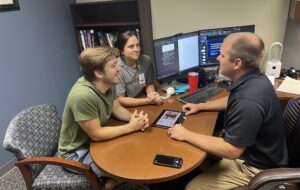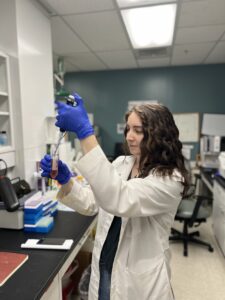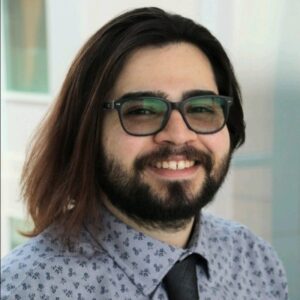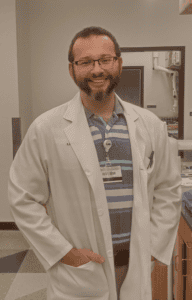Brian Parks, Ph.D.

Dr. Brian Parks (right), speaking with two nursing students
What are you currently doing?
As a Clinical Instructor in the UAMS College of Nursing, I have the privilege of teaching courses in pharmacology, pathophysiology, research methods, and scientific foundations in the Doctor of Nursing Practice programs. My role extends beyond traditional teaching, as I am actively involved in research that evaluates the use of AI and virtual patient simulation in graduate nursing education. This innovative approach aims to enhance the learning experience and outcomes for nursing students.
How has the PTET track prepared you for your career?
During my PTET training, I had the distinct advantage of being mentored by two experts (Dr. Brents and Dr. Berquist) from diverse backgrounds in basic science research. Their complementary expertise provided a comprehensive and high-quality training experience, significantly enhancing my knowledge and skill set. This mentorship was a pivotal factor in preparing me for a successful career, equipping me with the tools to excel in both teaching and research.
The PTET track was instrumental in providing the education necessary for me to successfully help graduate nursing students understand the scientific principles that guide the best clinical decisions for their patients’ well-being. This education allows me to bring a unique perspective and approach to clinical education within the College of Nursing. Additionally, the PTET track offered extensive research training in basic science, which I have seamlessly integrated into my nursing education research. This dual expertise in both teaching and research enriches my contributions to the academic community.
Katie M. McGraw
 What are you currently doing?
What are you currently doing?
I am currently a third-year graduate student working in the lab of Dr. Nirmala Parajuli. I study the complement system and its effect on mitochondria during kidney transplantation by utilizing animal models of transplant plus cold storage.
How has the PTET track prepared you for your career?
I am currently doing my Ph.D. in the PTET track and I was also fortunate to be given the opportunity to train as a T-SPaT fellow. Throughout my training, I have learned cutting-edge scientific techniques, microsurgical skills for animal models, and how to think critically about data analysis. I am also grateful in my program to have faculty who are always willing to take time and offer their expertise. I feel the PTET track and T-SPaT fellowship are preparing me excellently for a future career in science.
Joel Vazquez, Ph.D.
 What are you currently doing?
What are you currently doing?
I am currently a research toxicologist providing toxicology support for spaceflight missions at NASA, supporting both official NASA activities as well as third-party spaceflight missions.
How has the PTET track prepared you for your career?
The PTET track prepared me to perform toxicology risk assessments by providing me a foundational framework in determining the appropriateness of toxicology research methods, data generated, and translational value to human toxicology endpoints. The t-SPAT program specifically aided me in the translational aspect of research, helping me to ensure that animal models used for research are adequately posed to answer questions investigated by these studies. Additionally, as my work currently involves determination of safe dose thresholds/limits, a deep understanding of statistics has been necessary, and our statistics course has helped me immensely in ensuring that my determined limits were derived from statistically sound research methods, especially when deriving limits from statistical modeling methods such as the Benchmark Dose method.
Lance N. Benson, Ph.D.
 What are you currently doing?
What are you currently doing?
I am currently entering my second year as a postdoc working in the laboratory of Jennifer Pollock, Ph.D., at the University of Alabama at Birmingham (UAB). Current interests include exploring how circadian-mediated metabolic differences in T cells contributes to their recruitment and participation in the pathogenesis of hypertension.
How has the PTET track prepared you for your career?
I completed by Ph.D. in the PTET track and was funded by the T32 T-SPaT mechanism for two years. In the PTET track and under the excellent mentorship of Dr. Shengyu Mu, I was trained to consider each biological mechanism and response in the context of the entire system. This “big picture” approach to understanding the minute details has proven to be critical in properly planning each experiment for maximal scientific rigor and has greatly improved my scientific writing capabilities. Dr. Mu’s superb training extended far beyond the theory and the writing; the training he provided me in various techniques continues to provide me a competitive edge as a postdoc. I found the Mu laboratory and the entire PTET track to be incredibly supportive during my dissertation work characterizing a mechanism mediating the role of CD8+ T cells in the pathogenesis of hypertension, and comments/suggestions during the many cardiovascular group meetings (especially by Dr. Nancy Rusch) helped streamline my research. The monthly whiteboard meetings for T-SPaT trainees proved beneficial in ensuring I properly understood my own project and provided novel ideas and insights through learning about the ongoing work from other trainees. In short, I would recommend the PTET track to anyone.
